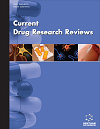- Home
- A-Z Publications
- Current Drug Research Reviews
- Previous Issues
- Volume 14, Issue 3, 2022
Current Drug Research Reviews - Volume 14, Issue 3, 2022
Volume 14, Issue 3, 2022
-
-
Are Histamine H3 Antagonists the Definitive Treatment for Acute Methamphetamine Intoxication?
More LessBackground: Methamphetamine (METH) is classified as a Schedule II stimulant drug under the United Nations Convention on Psychotropic Substances of 1971. METH and other amphetamine analogues (AMPHs) are powerful addictive drugs. Treatments are needed to treat the symptoms of METH addiction, chronic METH use, and acute METH overdose. No effective treatment for METH abuse has been establishe Read More
-
-
-
Cutting-edge Nanotechnological Approaches for Lung Cancer Therapy
More LessAuthors: Amaiyya Agrawal and Sankha BhattacharyaLung cancer is the second leading cancer with a high rate of mortality. It can be treated using different intervention techniques such as chemotherapy, radiation therapy, surgical removal, and photodynamic therapy. All of these interventions lack specificity, implying that it harms the normal cells adjacent to the infected ones. Nanotechnology provides a promising solution that increases the bioavailability of anticancer Read More
-
-
-
The Incredible Potential of Exosomes as Biomarkers in the Diagnosis of Colorectal Cancer
More LessColorectal cancer (CRC) is common cancer that is one of the leading causes of cancerrelated deaths around the world. The creation of new biomarkers for this disease is an important public health strategy for lowering the disease's mortality rate. According to new research, exosomes may be important sources of biomarkers in CRC. Exosomes are nanometer-sized membrane vesicles (30-200 nm) secreted by normal a Read More
-
-
-
Molnupiravir in COVID-19: A Scoping Review
More LessAuthors: Shilpa Kaore and Shubham AtalBackground: COVID-19, first detected in Wuhan, China, has evolved into a lifethreatening pandemic spread across six continents, with the global case count being more than 243 million, and mortality over 4.95 million, along with causing significant morbidity. It has initiated an era of research on repurposed drugs such as hydroxychloroquine, lopinavir/ritonavir, corticosteroids, remedesivir, ivermectin, alongside selective antivir Read More
-
-
-
Therapeutic Potential of Diacerein in Management of Pain
More LessAuthors: Vishal Patel, Amit Joharapurkar and Mukul JainDiacerein (DCN), an analogue of rhein (a glycosidal compound of natural origin), is currently used in the treatment of osteoarthritis and is given a fast-track designation for development to treat epidermolysis bullosa (EB). It is a nonsteroidal anti-inflammatory drug having disease-modifying properties in osteoarthritis and anti-inflammatory effects for the treatment of EB. Diacerein has a beneficial effect on pain relief and de Read More
-
-
-
Biochanin-A: A Bioactive Natural Product with Versatile Therapeutic Perspectives
More LessAuthors: Vadivelan Ramachandran, Inba K. V, Kiran Kumar hr, Ruchi Tiwari and Gaurav TiwariBackground: Biochanin-A (5,7 dihydroxy 4 methoxy isoflavone) is a phytochemical phytoestrogen that is highly effective against various diseases. Biochanin-A is a nutritional and dietary isoflavonoid naturally present in red clover, chickpea, soybeans and other herbs. Biochanin- A possesses numerous biological activities. Objective: The study focused on collective data of therapeutic activities of Biochanin-A. Methods: Accordi Read More
-
-
-
Dyslipidemia Secondary to the Use of HAART in Adults: A Systematic Review
More LessBackground: HIV infection affects millions of people globally. Currently, although several drugs have brought an improvement in the quality and life expectancy of these individuals, they are accompanied by several adverse effects. Objective: To conduct a systematic review of studies examining the relationship between antiretroviral therapy (ART) uses and secondary dyslipidemia. Methods: The review followed the criteria define Read More
-
-
-
Effect of Evening Primrose Vaginal Capsule on Cervix Preparation and Duration of First Stage of Labor in Nulliparous Women Referred to Fatemieh Hospital in Hamadan, Iran: A Single-blind Randomized Controlled Trial
More LessBackground: Cervix preparation is one of the main steps in the onset of labor and is very important for success in initiating or inducing labor. Objective: The present study aimed at investigating the effect of evening primrose vaginal capsule on the preparation of cervix and the consequences of labor in nulliparous women. Methods: This randomized clinical trial study was conducted in 2018 on 100 nulliparous wo Read More
-
Most Read This Month
Article
content/journals/cdrr
Journal
10
5
false
en


